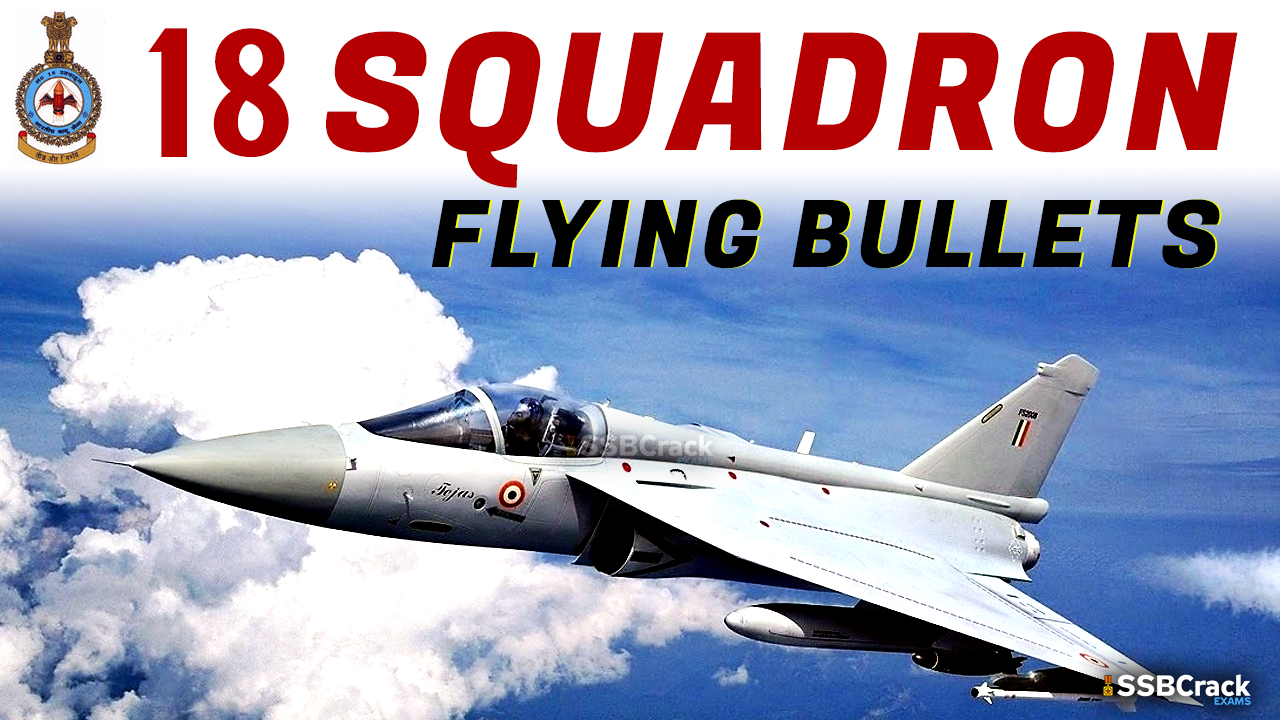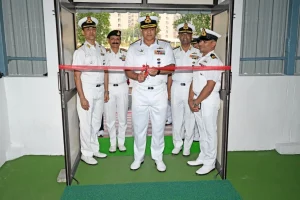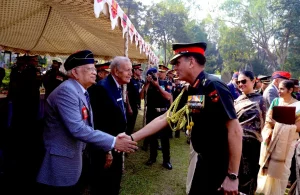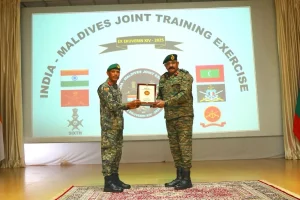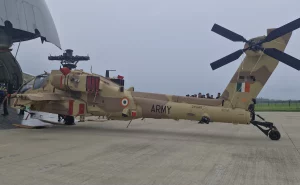What is the news?
- No. 18 Squadron (Flying Bullets), is an air-defence unit of the Indian Air Force, flying from Sulur Air Force Station.
- On 27 May 2020, the Final Order Cut-off (FOC) variant of Tejas Mk 1 will be inducted into this squadron by Chief of Air Staff RKS Bhadauria.
What is the history?
- The squadron flew the Indian license-built Mikoyan MiG-27ML in ground-attack role until the aircraft was withdrawn from Indian service in April 2016.
- The Squadron was resurrected on 1 April 2020, at Sulur, Tamil Nadu.
Since times immemorial…
- The Squadron was formed on 15 April 1965, with five Folland Gnats and eleven pilots, it operated out of Srinagar Air Force Station.
- A few pilots from this squadron flew operations with 9 Squadron and 2 Squadron during Indo-Pakistani war of 1965.
- The squadron first saw action during the Indo-Pakistan War of 1971, with the task of defending the Kashmir Valley. It operated out of AFS Srinagar, consisting of four aircraft, 17 officers and 72 men commanded by Wing Commander P Raina.
- After the war, in February 1975, the Gnats were phased out, and replaced by HAL Ajeets.
- In May 1989, when the squadron was at Hindon, they were replaced with MiG 27s.
- Its former role of Air Defence was changed to Ground-attack.
- The squadron received the Presidential Standard Award in 2015 and will be re-formed with the indigenous HAL Tejas on 27 May 2020.
The Aircrafts Used…
| Aircraft | From | To | Air Base |
| Folland Gnat | 15 April 1965 | February 1975 | Srinagar AFS |
| HAL Ajeet | February 1975 | May 1989 | Hindon AFS |
| MiG-27 ML | May 1989 | 15 April 2016 | Kalaikunda AFS |
| HAL Tejas | 27 May 2020 (planned) | Sulur AFS |
Some notes about the Tejas MK-I
- The value of the aerospace “self-reliance” initiative was not simply the production of an aircraft, but also the building of a local industry capable of creating state-of-the-art products with commercial spin-offs for a global market. The LCA programme was intended in part to further expand and advance India’s indigenous aerospace capabilities.
- In the early eighties, it was realised that no organisation existed which had the total capability to develop such an aircraft all on its own. The last time an indigenous fighter aircraft, the HF 24 flew was in 1961. Since then, the HF 24 assembly line had been shut down and the design team had been wound up. The only way left was to develop an aircraft from scratch.
- To better accomplish these goals, the government of India in 1984 decided to establish the Aeronautical Development Agency (ADA) to manage the LCA programme. Hindustan Aeronautics Limited, (HAL) was to be the principal partner with participation of various DRDO & CSIR Laboratories, Public & private sector industries and academic institutions.
- The Tejas is a single-engine multirole fighter which features a tailless, compound delta wing and is designed with “relaxed static stability” for enhanced manoeuvrability. Originally intended to serve as an air superiority aircraft with a secondary ground-attack role, its flexibility permits a variety of guided air-to-surface and anti-shipping weapons to be integrated for multirole and multimission capabilities. The tailless, compound-delta planform is designed to be small and lightweight. This platform also minimises the control surfaces needed (no tailplanes or foreplanes, just a single vertical tailfin), permits carriage of a wider range of external stores, and confers better close-combat, high-speed, and high-alpha performance characteristics than comparable cruciform-wing designs. Extensive wind tunnel testing on scale models and complex computational fluid dynamics analyses have optimised the aerodynamic configuration for minimum supersonic drag, a low wing-loading, and high rates of roll and pitch.
Finalizing Tejas Design Attributes:
- The LCA design was finalised in 1990 as a small tail-less delta winged machine with relaxed static stability (RSS) to enhance maneuverability performance and a host of other advanced features. A review committee was formed in May 1989 which reported that Indian infrastructure, facilities and technology had advanced sufficiently in most areas to undertake the project. It was decided that the full-scale engineering development (FSED) stage of the programme would proceed in two stages.
- Phase 1 – TECHNOLOGY DEMONSTRATION STAGE (TD-1 & 2)
The focus in this phase was on ‘proof of concept’. It entailed the development and testing of two technology demonstrator aircraft. These aircraft were called TD-1 and TD-2. The decision to move forward was to be taken after the successful completion of this phase. This would be followed by the production of additional prototype vehicles. There were teething issues during this phase and finally TD-1 flew on 04 January 2001 with Wing Commander Rajiv Kothiyal on the controls. The significance of this golden-day in the history of Indian aviation can be gauged by the fact that the last time an indigenous aircraft had got airborne was almost 40 years ago on 17 June 1961.
- Phase 2 – ADDITIONAL TESTING PHASE (PV-1, PV-2, PV-3 and PV-5)
This phase consisted of additional testing and development of systems using Prototype Vehicles which would lead to the development of the final variant that would join the IAF and the Indian Navy. The first Prototype Vehicle, PV-1 flew on 25 November 2003.
- By 2005, the Tejas had proven itself in the testing phase and the first order for 20 Series Production aircrafts was placed. A follow on order for an additional 20 SP aircraft was placed in 2010.
Specifications of Tejas MK-I
- Role: Multirole light fighter
- Manufacturer: Hindustan Aeronautics Limited
- Design group: Aeronautical Development Agency, Defence Research and Development Organisation, National Aerospace Laboratories
- First flight: 4 January 2001
- Introduction: 17 January 2015
- The maximum payload capability of Tejas is 5,300 kg.
- Total hardpoints = 7 (3 under each wing and 1 under-fuselage centerline)
- Auxiliary fuel tanks of 725, 800 and 1200 liters can be carried under the fuselage to extend range.
- An aerial refueling probe on the starboard side of the forward fuselage gives more capability to refuel in air.
- Stealth features have been designed into Tejas.
- RAFAEL’s Derby fire-and-forget missile will serve as the Tejas’ initial medium range air-air armament.
- The Brahmos NG supersonic cruise missile is being developed for the Tejas.
- Tejas uses Martin-Baker 16LG zero-zero ejection seat integrated with an indigenous CSS, or canopy severance system made by DRDO.
- Highest G-limit = +8.5g
Timeline for the Tejas Programme
- 1983 – DRDO got permission to initiate a programme to design and develop a Light Combat Aircraft.
- 1984 – Government of India set up Aeronautical Development Agency (ADA) as the nodal agency developing the LCA and managing the programme.
- 1985 – IAF generated Air Staff Requirements (ASR) for LCA in October 1985.
- 1986 – Government allocated Rs. 575 Crores for the LCA programme. Programme to develop an indigenous power plant (engine) – Kaveri was launched at GTRE.
- 1987 – Project definition commenced in October 1987 with French aircraft major Dassault Aviation as consultants.
- 1988 – Project definition phase completed in September 1988.
- 1989 – Government review committee expressed confidence in LCA programme. It was decided that the programme will be implemented in two phases.
- 1990 – Design of LCA was completed as a tail-less compound delta winged relaxed static stability aircraft. Phase 1 (Technology Demonstrator) of the development was commenced to create the proof of concept.
- 1993 – Full funding approved from April 1993 and development work for Phase 1 started in June.
- 1995 – First technology demonstrator, TD-1, rolled out on 17th November.
- 1997 – Multi-Mode Radar (MMR) for LCA design work started at HAL Hyderabad division and LRDE.
- 2001 – 4th January – the historic first flight of the Technology Demonstrator TD-1 marking a new era in the aviation history of India. Prime Minister Atal Bihari Vajpayee named LCA – “Tejas” meaning Radiance in ancient Indian language Sanskrit.
- 6th June 2002 – TD-2 made her successful maiden flight.
- 2003 – Tejas crossed the sonic barrier for the first time
- 25th November 2003 – PV-1 made her successful maiden flight.
- 1st December 2005 – PV-2 made her successful maiden flight.
- 1st December 2006 – PV-3 flew for the first time for 27 minutes at an altitude of 2.5 km and at a speed of Mach 0.8. PV-3 was equipped with a more advanced pilot interface, refined avionics and higher control law capabilities compared with the previous versions.
- 25th April 2007 – The first Limited Series Production LCA (LSP-1) made her first flight and reached a speed of Mach 1.1 in the very first flight. PV-2 and PV-3 underwent sea-level trials at INS Rajali Naval Air Station, Arakkonam to study the effects of flying at sea-level, as all earlier trials have been conducted at Bengaluru which is 3,000 feet (910 m) above sea-level. The reliability of the LCA systems under the hot and humid conditions, as well as low level flight characteristics was tested.
- 7th September 2007 – Tejas Prototype Vehicle (PV-1) made a successful flight with two external drop tanks of 800 Litres capacity
- 25th October 2007 – Tejas PV-1 fired R-73 (CCM) missile for the first time. The trials were conducted off the Goa coast at INS Hansa Naval Air Station.
- 11th December 2007 – LITENING targeting pod was successfully tested on Tejas PV-2.
- 28th May to 4th June 2008 – LCA Tejas prototypes PV-2 & PV-3 underwent hot weather trials at Air Force Station, Nagpur.
- 16th June 2008 – Tejas second Limited Series Production LCA (LSP-2) made its first flight.
- 7th November 2008 – LCA Prototype Vehicle-3 made first successful night flight.
- 13th December 2008 – PV-3 and LSP-2 completed the high-altitude test at Leh, world’s highest operational airfield.
- 22nd January 2009 – Tejas completed 1000 flights.
- October 2009 – PV-3 and LSP-2 completed air-to-ground weapons delivery trials.
- 26th November 2009 – Two-seater (Trainer) version of Tejas (PV-5) made its maiden flight on 26 Nov 09.
- 7th December 2009 – Tejas speed envelope expanded to 1350 km/h (CAS) while performing flight flutter test in a dive to near sea level. These tests were conducted at INS Hansa, Goa.
- 6th June 2010 – TD-2 made her successful maiden flight.
- 23rd April 2010 – LCA Tejas LSP-3 made maiden flight. LSP-3 is close to the final configuration including the new air-data computers. Multi-Mode Radar, new communication and navigation equipment and radar warning receiver. With this the LCA programme has completed 1350 test flights logging about 800 flying hours.
- 2nd June 2010 – First Flight of LCA Tejas LSP-4. Flight. In addition to the LSP-3 standard of preparation, the aircraft also flew with the Countermeasure Dispensing System.
- 19 November 2010 – First Flight of LCA Tejas LSP-5.
- 10th January 2011 – Certification for the Release to Service.
- 9th March 2012 – The Tejas Light Combat Aircraft, LSP-7 accomplished its maiden flight from HAL Airport in Bengaluru on 9th March 2012
- 29th April 2012 – The Naval version of the Indian Light Combat Aircraft Tejas, made its maiden flight from the HAL Airport in Bengaluru. This was a significant milestone in the history of Indian Aviation in designing a naval variant of a fighter aircraft.
- 22nd February 2013 – The LCA took part in the Iron Fist Exercise in Pokhran, Jaisalmer
- 31st March 2013 – The Tejas Light Combat Aircraft, LSP-8 accomplished its maiden flight from HAL Airport, Bengaluru
- 20th December 2013 – Initial Operation Clearance – 2. Indian Defence Minister Mr. A.K. Antony handed over the “Release to Service Document” of the country’s own Light Combat Aircraft to The Chief of Air Staff Air Chief Marshal NAK Browne.
- 1st October 2014 – First Flight of LCA Tejas SP 1 – The first Tejas Light Combat Aircraft from the batch of 20 ‘series production’ or full-fledged fighters flew for about 25 minutes in Bengaluru. The flight of ‘SP1’ was piloted by HAL’s Chief Test Pilot Air Cmdre K.A. Muthanna(Retd). The First Flight of SP1 was achieved within nine months of receiving the penultimate flight worthiness certification, called IOC-2 (initial operational clearance) in December 2013.
- 8th November 2014 – LCA Tejas PV-6 (Prototype Vehicle 6), a final configuration two-seater trainer aircraft, successfully completed its maiden flight at the HAL Airport in Bengaluru.
- 20th December 2014 – Maiden Ski Jump of LCA NP-1 – The first prototype of the light combat aircraft (LCA) Tejas Naval version – LCA NP-1 completed its maiden flight as part of the carrier compatibility tests at the shore-based test facility in Goa.
- 17th January 2015 – IAF gets first indigenously built Light Combat Aircraft Tejas – The LCA Tejas Series Production-1 (SP1) was handed over by Defence Minister Mr. Manohar Parrikar to Indian Air Force Chief Air Marshal Arup Raha in Bengaluru on Saturday.
- 7th February 2015 – The Second Prototype of the Light Combat Aircraft, the NP-2, flew her maiden flight on 7th February 2015 from HAL Airport in Bengaluru. Piloted by Capt. Shivnath Dahiya (Indian Navy), the aircraft performed flawlessly in the first flight
- 21st – 23rd January 2016 – India’s indigenous Light Combat Aircraft Tejas for the first time participated in an International Air Show in Bahrain, an event witnessed by External Affairs Minister of India Smt. Sushma Swaraj. The display of India’s defence technology comes at a time when the government is giving a strong push to its flagship ‘Make in India’ programme.
- 18th May 2016 – IAF Chief Arup Raha has his first sortie in LCA Tejas; says it is a “good aircraft” for induction. Indian Air Force (IAF) chief Arup Raha on18th May 2016 had his first sortie in the Light Combat Aircraft (LCA), after which he called it a “good aircraft for induction”. “It is my first sortie in Tejas, it is a good aircraft for induction into IAF operations,” Raha said.
- 1st July 2016 – Historical day for India: First squadron Inducted into the IAF. Hindustan Aeronautics Limited handed over the first two Tejas aircrafts to Indian Air Force which will make up the ‘Flying Daggers’ 45, the name of the first squadron of the LCA.
- August 2016 – Leh – High Altitude and Hot Weather Trials: The Tejas Trainer PV-6 (KH-T-2010) underwent High Altitude and Hot Weather Trials in Leh. Along with the machine, the men responsible for the activities also gained more experience by the harsh weather conditions.
- 8th October 2016 – LCA Tejas Makes Debut Appearance At 84th Air Force Day Celebrations. India’s Light Combat Aircraft Tejas performed at the 84th Air Force Day Celebrations amid Loud Cheers from the audience at the Hindon Air Force Base on the outskirts of New Delhi. Rising up to the expectations to the theme of this year’s IAF Day “MAKE IN INDIA”
- 8th November 2016 – The Ministry of Defence gives clearance for 83 LCA Tejas MK1A
- 26th January 2017 – LCA Tejas made its debut at the 68th Republic Day parade. Three Tejas aircrafts participated in the fly-past
- 14th to 18th February 2017 – LCA Tejas successfully participated in the 11th Aero India Air Show in Bengaluru
- 3rd March 2017 – LCA Tejas SP-4 flew for the first time
- 11th May 2017 – LCA Tejas LSP-4 Fires Derby Missile: Derby Missile in RADAR guided mode was fired from LCA Tejas LSP-4. The missile achieved a direct hit during the trial conducted at Kalaikunda, West Bengal.
- 30th June 2017 – LCA Tejas SP-6 flew for the first time
- 8th October 2017 – LCA Tejas Participates in 85th Air Force Day Celebrations with ground and aerial display by the Tejas
- 28th November 2017 – Singapore Defence Minister Dr. NG Eng Hen flies in the LCA Tejas Trainer with Air Vice-Marshal A.P Singh. As the first civilian foreigner, Dr. Eng Hen took a half-an-hour flight in Tejas at the Kalaikunda airbase and said, “It is an excellent aircraft and it is very impressive.”
- 12th December 2017 – LCA Tejas SP-7 flew for the first time
- 7th January 2018 – LCA Tejas at the 69th Republic Day parade: LCA Tejas flew for the second consecutive year at the 69th Republic Day parade. Three Tejas aircrafts participated in the fly-past.
- 3rd February 2018 – General David L Goldfein, Chief of Staff of US Air Force flew in the Tejas in a special flight that took off from the Jodhpur Air Force Station. The US Air Force chief was accompanied by Air Vice Marshal AP Singh as co-pilot during the 40-minute sortie. General Goldfein is the first foreign chief commander to fly in the Tejas
- 7th February 2018 – General André Lanata, Air Force Chief of Staff, French Air Force flew a sortie in the LCA Tejas at Air Force Station in Jodhpur.
- 9th February 2018 – LCA Tejas SP-5 flew for the first time
- 13th March 2018 – LCA Tejas SP-8 flew for the first time
- 24th March 2018 – LCA Tejas SP-9 flew for the first time
- 8th to 21st April 2018 – LCA Tejas participates at IAF Gagan Shakti Exercise 2018: The Tejas was put to trial by the Indian Air Force (IAF) in war-like operational conditions during Gagan Shakti, its biggest ever 14-day war exercise. The exercise started on April 8 and concluded on April 21. A total of eight Tejas Aircrafts were deployed during the exercise.
- 27th April 2018 – LCA Tejas LSP-7 Fires Derby BVR Missile: The Missile Achieves Full Operational Capability leading to an important element for FOC of Tejas.
- 27 May 2020 – The Final Order Cut-off (FOC) variant of Tejas Mk 1 will be inducted into No. 18 Squadron at Sulur AFS by Chief of Air Staff RKS Bhadauria.
